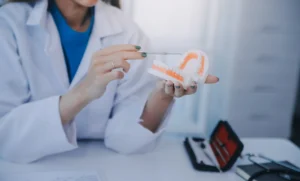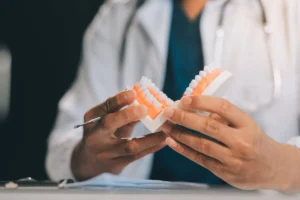Teeth whitening is one of the most popular treatments in modern cosmetic dentistry. After all, who doesn’t want a nice white smile? Teeth whitening makes teeth seem cleaner and whiter and there is an abundance of at-home teeth whitening kits available on the market.
But how do these at-home teeth whitening kits work? What are the risks involved with them? The answers to these and more questions concerning at-home teeth whitening kits coming up in a moment.
How Does Teeth Whitening Work?
Teeth whitening is a chemical process that removes “chromogens” which are the organic compounds responsible for tooth staining. The amount of contact time and concentration of the product determines the effectiveness of the whitening product.
Teeth whitening products use chemicals like Hydrogen Peroxide (H2O2) to remove stains from the teeth. Whitening toothpastes are chiefly composed of detergents and abrasives which help in the removal of chromogens from the surfaces of your teeth.
Adverse Effects of Teeth Whitening
Proper use of your teeth whitening products is safe. Nevertheless, if they are not used properly or as directed by the manufacturers, certain complications can develop.
Here are some of the adverse effects these products can cause if they are not applied correctly:
- Sensitive teeth
- Periodontal problems
- Loss of mineral content in teeth
- Damage to the pulp within the teeth
- Tooth erosion
Tray-Based Teeth Whiteners
Tray based whitening kits can be provided by a dental professional. The applied gel will take about 15 minutes to 30 minutes twice a day for ten to fourteen days. This type of product has been found to be the most effective to whiten teeth at home because of the fit of the custom tray and the consistency and concentration of the gel. .The gel remains in contact with the tooth for a longer period of time which makes it the most effective at-home whitening procedure.
Over the Counter Whitening Strips and Gels
Whitening strips contain a peroxide gel that works to bleach and remove stains. These strips will slowly release the peroxide to the teeth over the span of about 30 minutes which maximizes the whitening capacity.
Whitening Toothpaste
A tooth whitening toothpaste is designed with special abrasives and detergents designed to effectively remove stains from the surface of the teeth. Carbamide peroxide and hydrogen peroxide are two common cleansers found in teeth whitening toothpaste.
Whitening Rinses
Oral rinses also contain whitening and bleaching agents like hydrogen peroxide that work to remove chromogens. The amount of contact time is minimal therefore limiting the effectiveness of the whitening rinses.
When Not to Use At-home Teeth Whitening Kits
As with any other treatment of any sort, you will want to consult your health provider before you begin with a teeth whitening treatment. Here are some of the reasons your dentist may not recommend whitening:
Allergic to peroxide
Dental health problems
Fillings, crowns, or dental restorations
Braces
Prescription drugs
These are the basic guidelines to keep in mind when considering teeth whitening treatment for yourself or your family. Contact the experts at Dixon Dental Center for more information on teeth whitening treatments.




